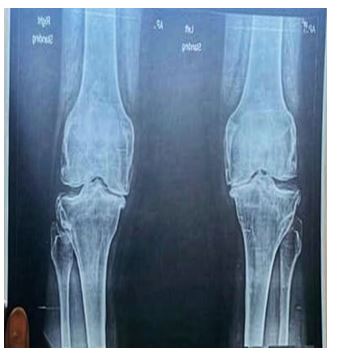Comprehensive Ayurvedic management of Sandhigata Vata : A Case Report
DOI:
https://doi.org/10.21760/jaims.8.12.42Keywords:
Sandhigatavata, Osteoarthritis, Pizhichil, Panchtikta Ksheera Basti, Panchtikta Ghrita GugguluAbstract
Sandhigata Vata is a disease associated with aging. This particular form of Vatavyadhi is mostly found in Vriddhavastha as a result of Margavarodha, which restricts daily tasks like dressing, walking, taking a bath, and so on, leaving patients incapacitated or handicapped. Treatment options include NSAIDs, calcium supplements, and finally joint replacement. In this case, arthroplasty was advised due to bilateral osteoarthritis in the knees. Pain, edema, range of motion, and walking distance all improved significantly once the therapy was completed. Internal medicine, Janu Pizhichil, and Panchtikta Ksheer Basti therapy were used to successfully treat the patient. Case: A 65 years old male patient was clinically diagnosed as a case of Sandhivata presented with the following chief complaints from 1 month. It was associated with swelling in B/L knee joint with pain, tingling sensation in right unilateral knee joint. Management: Patient was treated with Janu Pizhichil (oil bath for knee joint), Panchtikta Ksheer Basti (medicated enema) and internal medication like Panchatikta Ghrit Guggulu. Conclusion: It can be concluded that use of Baahyaparimarjan Chikitsa (classical external Ayurvedic treatment) in the background of accurate diagnosis can cure the patients suffering from osteoarthritis also no osteoporotic changes were observed in 1 month. Being safe, devoid of adverse effects, ayurvedic management is the only option to avoid painful intervals, advancement of the disease and repeated use NSAIDs.
Downloads
References
Mandhane R. Contribution Of Ayurveda For Management Of Sandhivat. ResearchGate. June 2021.
Ashtankar P. Comprehensive Ayurvedic management of Sandhigatavata: a case report. J Indian Sys Medicine. January 2019.
Rathod D, Dattani K. Effect of Yoga Basti in Sandhivata w.s.r. to osteoarthritis of the knee joint. Int J Ayur Med. 2017;8:73-9.
Trikamji Y, editor. Chikitsasthan; Vatavyadhichikitsa Adhyaya. Verse 37. In: Charakasamhita of Agnivesha. Varanasi, India: Chaukamba Publication; 2011. p. 690.
Shastri K, editor. Nidhanasthana; Vatavyadhinidan Adhyaya. Verse 29. In: Sushruta, Sushruta Samhita. Varanasi, India: Chaukhamba Sanskrit Sansthan; 2012. p. 460.
Gupt A, editor. Nidanasthana; Vatavyadhinidan Adhyaya. Verse 5–6. In: Shrimadvagbhat, Astanghrudayam. Varanasi, India: Chaukhambha Sanskrit Samsthan; 2005. p. 375.
Bhaishajya Ratnavali, Edited by Rajeshwar Dutta Shastri. Chaukhambha Sanskrit Santhan, Varanasi.
Harrison’s Principle of Internal Medicine, 17th edition, vol. 1 & 2, 2008.
Davidson's Principles & Practice of Medicine, 20th edition reprint, 2008.
Harsh Mohan Textbook of Pathology, 6th Edition, 2010.
Sawarkar G, Suple Y. Prevention and management of osteoarthritis. Int J Res Ayurveda Pharm. 2013;4:22.















